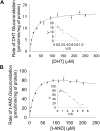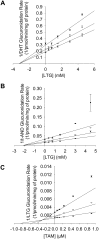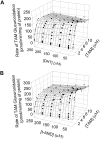Glucuronidation of dihydrotestosterone and trans-androsterone by recombinant UDP-glucuronosyltransferase (UGT) 1A4: evidence for multiple UGT1A4 aglycone binding sites
- PMID: 20007295
- PMCID: PMC2835394
- DOI: 10.1124/dmd.109.028712
Glucuronidation of dihydrotestosterone and trans-androsterone by recombinant UDP-glucuronosyltransferase (UGT) 1A4: evidence for multiple UGT1A4 aglycone binding sites
Abstract
UDP-glucuronosyltransferase (UGT) 1A4-catalyzed glucuronidation is an important drug elimination pathway. Although atypical kinetic profiles (nonhyperbolic, non-Michaelis-Menten) of UGT1A4-catalyzed glucuronidation have been reported occasionally, systematic kinetic studies to explore the existence of multiple aglycone binding sites in UGT1A4 have not been conducted. To this end, two positional isomers, dihydrotestosterone (DHT) and trans-androsterone (t-AND), were used as probe substrates, and their glucuronidation kinetics with HEK293-expressed UGT1A4 were evaluated both alone and in the presence of a UGT1A4 substrate [tamoxifen (TAM) or lamotrigine (LTG)]. Coincubation with TAM, a high-affinity UGT1A4 substrate, resulted in a concentration-dependent activation/inhibition effect on DHT and t-AND glucuronidation, whereas LTG, a low-affinity UGT1A4 substrate, noncompetitively inhibited both processes. The glucuronidation kinetics of TAM were then evaluated both alone and in the presence of different concentrations of DHT or t-AND. TAM displayed substrate inhibition kinetics, suggesting that TAM may have two binding sites in UGT1A4. However, the substrate inhibition kinetic profile of TAM became more hyperbolic as the DHT or t-AND concentration was increased. Various two-site kinetic models adequately explained the interactions between TAM and DHT or TAM and t-AND. In addition, the effect of TAM on LTG glucuronidation was evaluated. In contrast to the mixed effect of TAM on DHT and t-AND glucuronidation, TAM inhibited LTG glucuronidation. Our results suggest that multiple aglycone binding sites exist within UGT1A4, which may result in atypical kinetics (both homotropic and heterotropic) in a substrate-dependent fashion.
Figures








Similar articles
-
Functional analysis of UGT1A4(P24T) and UGT1A4(L48V) variant enzymes.Pharmacogenomics. 2011 Dec;12(12):1671-9. doi: 10.2217/pgs.11.105. Epub 2011 Nov 2. Pharmacogenomics. 2011. PMID: 22047493
-
Quaternary ammonium-linked glucuronidation of trans-4-hydroxytamoxifen, an active metabolite of tamoxifen, by human liver microsomes and UDP-glucuronosyltransferase 1A4.Biochem Pharmacol. 2006 Apr 28;71(9):1358-69. doi: 10.1016/j.bcp.2006.01.004. Epub 2006 Feb 14. Biochem Pharmacol. 2006. PMID: 16480962
-
In vitro characterization of lamotrigine N2-glucuronidation and the lamotrigine-valproic acid interaction.Drug Metab Dispos. 2006 Jun;34(6):1055-62. doi: 10.1124/dmd.106.009340. Epub 2006 Mar 24. Drug Metab Dispos. 2006. PMID: 16565174
-
Characterization of tamoxifen and 4-hydroxytamoxifen glucuronidation by human UGT1A4 variants.Breast Cancer Res. 2006;8(4):R50. doi: 10.1186/bcr1539. Breast Cancer Res. 2006. PMID: 16884532 Free PMC article.
-
Quaternary ammonium-linked glucuronidation of tamoxifen by human liver microsomes and UDP-glucuronosyltransferase 1A4.Biochem Pharmacol. 2004 Jun 1;67(11):2093-102. doi: 10.1016/j.bcp.2004.02.014. Biochem Pharmacol. 2004. PMID: 15135306
Cited by
-
Bilirubin glucuronidation revisited: proper assay conditions to estimate enzyme kinetics with recombinant UGT1A1.Drug Metab Dispos. 2010 Nov;38(11):1907-11. doi: 10.1124/dmd.110.033829. Epub 2010 Jul 28. Drug Metab Dispos. 2010. PMID: 20668247 Free PMC article.
-
Correlation between bilirubin glucuronidation and estradiol-3-gluronidation in the presence of model UDP-glucuronosyltransferase 1A1 substrates/inhibitors.Drug Metab Dispos. 2011 Feb;39(2):322-9. doi: 10.1124/dmd.110.035030. Epub 2010 Oct 28. Drug Metab Dispos. 2011. PMID: 21030469 Free PMC article.
-
A potential role for human UDP-glucuronosyltransferase 1A4 promoter single nucleotide polymorphisms in the pharmacogenomics of tamoxifen and its derivatives.Drug Metab Dispos. 2014 Sep;42(9):1392-400. doi: 10.1124/dmd.114.058016. Epub 2014 Jun 10. Drug Metab Dispos. 2014. PMID: 24917585 Free PMC article.
-
Glucuronidation of [6]-shogaol, [8]-shogaol and [10]-shogaol by human tissues and expressed UGT enzymes: identification of UGT2B7 as the major contributor.RSC Adv. 2018 Dec 12;8(72):41368-41375. doi: 10.1039/c8ra08466a. eCollection 2018 Dec 7. RSC Adv. 2018. PMID: 35559294 Free PMC article.
-
First-pass metabolism via UDP-glucuronosyltransferase: a barrier to oral bioavailability of phenolics.J Pharm Sci. 2011 Sep;100(9):3655-81. doi: 10.1002/jps.22568. Epub 2011 Apr 11. J Pharm Sci. 2011. PMID: 21484808 Free PMC article. Review.
References
-
- Chouinard S, Tessier M, Vernouillet G, Gauthier S, Labrie F, Barbier O, Bélanger A. (2006) Inactivation of the pure antiestrogen fulvestrant and other synthetic estrogen molecules by UDP-glucuronosyltransferase 1A enzymes expressed in breast tissue. Mol Pharmacol 69:908–920 - PubMed
-
- Fisher MB, Campanale K, Ackermann BL, VandenBranden M, Wrighton SA. (2000) In vitro glucuronidation using human liver microsomes and the pore-forming peptide alamethicin. Drug Metab Dispos 28:560–566 - PubMed
-
- Fujiwara R, Nakajima M, Yamanaka H, Katoh M, Yokoi T. (2008) Product inhibition of UDP-glucuronosyltransferase (UGT) enzymes by UDP obfuscates the inhibitory effects of UGT substrates. Drug Metab Dispos 36:361–367 - PubMed
-
- Galetin A, Clarke SE, Houston JB. (2002) Quinidine and haloperidol as modifiers of CYP3A4 activity: multisite kinetic model approach. Drug Metab Dispos 30:1512–1522 - PubMed
Publication types
MeSH terms
Substances
Grants and funding
LinkOut - more resources
Full Text Sources

